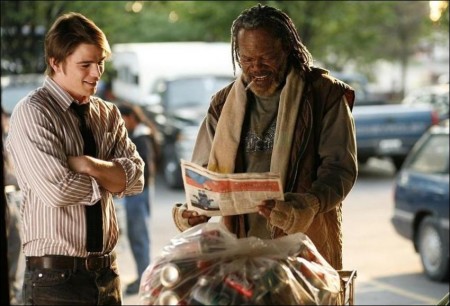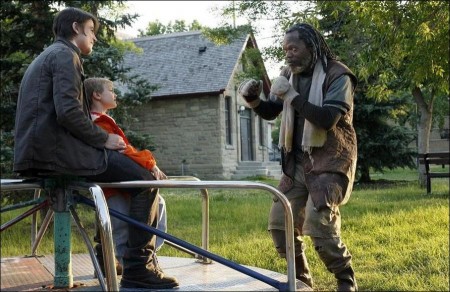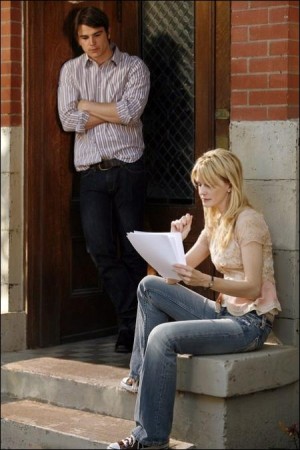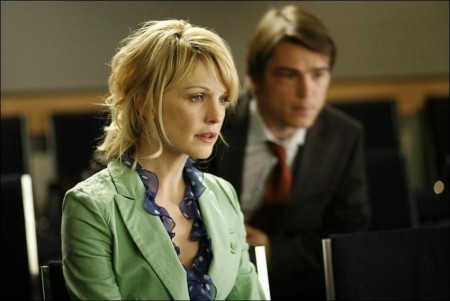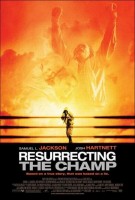Living on the streets of Denver, pushing a shopping cart piled high with all his worldly possessions, the man everyone calls “The Champ” (Samuel L. Jackson) knows he was not the greatest boxer to ever step in the ring, but at least he had a shot at it. After years of succumbing to fighters who ultimately found his glass jaw more often than he landed a winning punch, the Champ went from up-and-coming to mere has-been, with no heavyweight championship under his belt. Now he fights no one but cops and street thugs. Living in the shadow of his former self, this champ is down and halfway out.
Denver Times sports reporter Erik Kernan (Josh Hartnett) knows the feeling. He’s been living in the shadow of his famous father Erik the “Wow Man” Kernan ever since he too decided to be a journalist. Listening to tapes of his old man’s lively radio broadcasts — Erik is aware that he has some big journalistic shoes to fill. Assigned to cover all the bush-league sporting events, he wants a shot and the big time, but his hard-driving editor Metz (Alan Alda) is quick to tell Erik he’s just not cutting it.
Rapidly losing ground at work and at home – his wife Joyce (Kathryn Morris) has asked for a separation – Erik is afraid of becoming an absent father to his son Teddy (Dakota Goyo) just like his father was to him. He needs to make changes, to put heart back into his life and into his work… but how?
One night after leaving the paper, as Erik sees a gang of thugs beating up a homeless man. He notices how well the grizzly old fellow can take a punch. He bobs, he weaves, he lands a few good ones himself until Erik chases the thugs away, leaving jeers of how they beat “The Champ” in their wake.
Erik realizes he has just rescued the legendary “Battling Bob Satterfield” and stumbled on the story of a lifetime. But rumor had it Satterfield was dead… and yet here he was. An article about the rise, fall and resurrection of a former heavyweight contender could get Erik’s career off the ropes and breathe life into his confidence. A story like this could be the title shot he has been waiting for a chance to change his life forever.
A Knockout Film Based on a True Story with Punch
On May 4, 1997, Los Angeles based-reporter J.R. Moehringer published an article that retraced the life of a former legendary boxer who went from being a Chicago City Golden Gloves Champion to narrowly missing a shot at a title fight and wound up homeless on the mean streets of California.
How did a man who Ring Magazine once ranked 58th on a list of 100 greatest punchers of all time, an impressive roster that included Joe Louis, George Foreman, Rocky Marciano, Sugar Ray Robinson and Mike Tyson, but did not include Muhammad Ali, end up sleeping under cardboard and fending off punks in dark alleys?
In a heartfelt article entitled “Resurrecting the Champ,” Moehringer explores the rise and fall of his subject, and in the process he confronts not only his subject’s demons, but also his own. Calling him his “180-pound Moby Dick,” Moehringer writes that, like Ahab, he stalked his subject and learned more than he bargained for about himself in the process. He also explained how he gained a greater understanding about “the eternal tension between fathers and sons.” For like Erik Kernan in the film version of Resurrecting the Champ, J.R. Moehringer never got to know his father either. And like Erik, it haunted him.
“Asked to explain myself, I usually start with my father, who disappeared when I was seven months old”, writes Moehringer. “He walked away from his only son the way some people leave a party that’s grown dull. At precisely the moment I learned to crawl, he ran. An unfair head start, I always felt.”
Phoenix Pictures’ Mike Medavoy could not help but feel the emotion in every one of Moehringer’s words, and shortly after the article was printed, he bought the film rights. The co-founder of Orion Pictures (Platoon; The Silence of the Lambs), as well as the chairman of Tri-Star Pictures (Sleepless in Seattle; Philadelphia), Medavoy knew good material when he saw it.
“It’s very rewarding to help launch a picture that you truly believe in, a film that really has something to say about humanity,” says Medavoy. “I think this is a movie that really explores relationships and I know it will really touch people.”
Director Rod Lurie had also read Moehringer’s article and was determined to make the film. “It’s such a wonderful story about fathers and sons and the honesty between them,” says Lurie, writer and director of the critically acclaimed political thriller, The Contender. “It’s also about a profound friendship that develops between two people who are very different, and ultimately very similar. I’m proud I got the chance to explore the story on film.”
Producer Marc Frydman, who had worked with Lurie on The Contender and later on Commander in Chief, was certain Lurie would be the perfect candidate to direct Resurrecting the Champ. “Rod used to be an entertainment journalist, so he knows the pressure a reporter feels to check the facts and deliver a good story,” says Frydman. “Besides that, he actually boxed at West Point and is a true lover of the sport. There was no better man for the job.”
Since the story is so profound, Lurie admits that there were several people interested in making the film. “I really had to fight to see this picture come to life and those of us involved have always felt very personal toward the material,” he says. “It was as though by making this film we would all become better people, and in fact, I think that’s what happened.”
A Cast of Real Contenders
One of the key elements in getting a film off the ground, besides good material and a well-written script, is the ability to attract a strong cast. With no less than three Academy Award nominees, and several Emmy and Golden Globe winners on board, Resurrecting the Champ was primed to go the distance to the big screen.
“I am truly delighted with every actor who came on board this film, but to have such a powerhouse as Sam Jackson in the title role, I couldn’t have asked for anything more,” says Lurie. “I like to take an actor of his caliber – one who has such an iconic image – away from that image and plant him in a role that is unexpected. Since Sam usually portrays strong-willed, strong-bodied characters, I loved the notion of casting him as someone who is, as the Champ says, `down and almost halfway out.’ In fact, I can’t recall an actor transforming himself into a person of the streets like this in such a unique way since Dustin Hoffman literally embodied Ratso Rizzo in Midnight Cowboy.”
Oscar-nominee Samuel L. Jackson (Pulp Fiction; Star Wars I-III) was eager to delve into such a fascinating character. “This guy is a fallen hero of sorts, a man who wants so much to be somebody else that he winds up being nobody,” observes Jackson. “I had to dig deep into parts of myself I didn’t particularly like going to in order to find the Champ, but it was a journey well worth taking.”
Playing opposite Jackson, Josh Hartnett (The Black Dahlia; Lucky Number Slevin; Black Hawk Down), had his hands full, but he certainly proved to be up to the challenge.
“I was drawn to Josh because I have tremendous respect for the choices he’s made in his career,” says Lurie. “With his good looks he could have easily gone with multi-million dollar projects and the movie star route, but Josh has always been very selective about the roles he takes on, roles with a lot of heart and complexity like this one.”
Hartnett was eager to tackle the multifaceted character. “The truth is, I’m not a father nor have I ever played one before, so this has been a real adventure for me,” admits the young actor. “I loved both the honesty and the flaws of Erik’s character. It was an honor to portray him as well as to work with such an amazing director, cast and crew.”
Lurie especially liked the way Hartnett handled himself opposite veteran actors and newcomer Dakota Goyo, who played Teddy his six-year old son. “Josh has a lot of emotionally charged roles to fill in this film, and they are all wrapped up in one very complex character,” observes Lurie. “He’s a beleaguered reporter with no confidence opposite Alan Alda. He is the up-and-coming it guy full of bravado opposite Teri Hatcher. He then has to switch gears completely to portray the estranged husband and caring father opposite Kathryn Morris and Dakota Goyo – and all the while, he’s swapping dialogue with the likes of Sam Jackson! Needless to say, Josh had a multilevel character to play, and I think he did a tremendous job.”
Cold Case star Kathryn Morris took on the difficult task of playing the wife of such a multifaceted character, and Lurie says she was the actor he had in mind from the start. “Kathy had to be both a firm moral barometer for Erik as well as an empathetic soul, and she really infused just the right amount of pluck and compassion into her portrayal,” observes Lurie. “In fact, both Kathy and Josh had to maneuver their way through a lot of emotion in this film and they did it beautifully.”
Although it was Hartnett and Jackson who were on screen most of the time, several of the actors who were in the film for only a short period truly made an impact. “Alan Alda lent just the type of authoritative air I was looking for as the tough newspaper editor. He pushes Erik’s character and makes him want to prove himself that much more,” observes Lurie. “Alan’s not only an Oscar nominee, but a multiple Golden Globe and Emmy winner, and his presence alone gives the film a higher stature.”
Also lending star power to the film is Golden Globe winner and Emmy nominee Teri Hatcher, whose Desperate Housewives role also earned her a nomination as Favorite Female Television Star at the 2006 People’s Choice Awards. In Resurrecting the Champ, Hatcher portrays Flak, the ethically-challenged Showtime executive who tries to seduce Erik not only up to her hotel room but also into a high-paying, but journalistically unchallenging position at the network.
“Teri’s character shows up at a very pivotal moment in the film. She offers Erik a shot at the big time, but the catch is she’s also asking him to sell his journalistic soul,” observes Lurie. “In fact, her character is literally the embodiment of temptation, and I could not think of a better person for the role than Teri Hatcher. I was overjoyed when she agreed to take the part, and even though she was on screen for only a few scenes, she really grabs the viewer like she always does.”
Rounding out the eclectic cast of characters is Oscar and Golden Globe nominee David Paymer (Mr. Saturday Night; Crime of the Century) as Whitley, the magazine editor who encourages Erik to write the article about the Champ; Rachel Nichols (Alias) as Polly, Erik’s trusty researcher; Harry Lennix (Commander in Chief) as Bob Satterfield’s son; and Emmy nominee Peter Coyote (The 4400; Commander in Chief) as Satterfield’s former manager.
“This was a real ensemble cast and they were all in each other’s corner no matter how much onscreen time they had,” says Lurie. “They gave the film the humanity that the movie itself offers to the audience, and I am proud to have worked with each and every one of them.”
A Film About Truth Demands Authenticity
When everyone involved with bringing Resurrecting the Champ to the big screen read the soul-searching truth that ran through every word in J.R. Moehringer’s article, it became the utmost of priorities to make the film as genuinely true to the spirit of the article as possible. To that end, Lurie wanted to capture the powerful authenticity of the newsroom in All the Presidents Men, so instead of constructing a set of a newsroom, he shot in a real one.
For logistical and financial reasons, Lurie chose to film in Calgary. The story was set in Denver though because the look of the city was a better match. It also made it possible to shoot later key exteriors in Denver itself so that when audiences see the Bronco’s training ground and John Elway’s restaurant (where he makes a cameo appearance), they are looking at the real thing.
The newsroom scenes were also authentic, shot over six days right in the middle of the Calgary Herald. “I wanted to show the actual hustle and bustle that goes on in such a place,” says Lurie. “We didn’t even ask people to stop working while we filmed and some of the real staffers actually found themselves in the movie.”
Similarly, the production filmed at a real homeless shelter called The Mustard Seed and wound up hiring approximately forty of the shelter’s residents and guests to be extras. “The caring individuals at The Mustard Seed opened their arms to us as they do to everyone,” remembers Lurie. “We wanted to make them part of something special and special is what they gave us in return.”
The boxing flashbacks were filmed at the Corral Arena at the Calgary Stampede Grounds and at a local ranch. Eric Bryson, the film’s boxing choreographer and stunt coordinator, was one of Lennox Lewis’ former sparring partners, and he was dedicated to recreating the boxing style of the fifties. He also wanted to bring a sense of continuity to the fighting styles of the older Champ, portrayed by Samuel L. Jackson, and the young Champ, portrayed by Troy Amos-Ross, a real-life Olympian boxer and Canadian Cruiserweight Champion.
“Troy’s eyes conveyed all the hopes and dreams of the young Champ, and I was delighted to find that he could act as well,” recalls Bryson, who also choreographed the stunts in the sci-fi action thrillers The Day After Tomorrow and Rollerball. “I was also very impressed by Sam Jackson’s extraordinary ability to reproduce Troy’s style and memorize a fight sequence after watching it for only a few minutes. It turns out that Jackson had boxed as a young man and had competed in a few fights when he was nineteen, so he was able to draw on that experience and bring a greater sense of authenticity to his movements.”
Bryson added that Lurie was literally hands on with his support. “Rod came down to the club and actually put the gloves on himself,” remembers Bryson. “He got right into the ring and he honestly surprised me. He showed exactly what movements he needed from the fighters and so they were able to give him what he wanted.”
In addition to working with Troy and Jackson, Bryson succeeded in finding excellent boxers who actually looked like the fighters they were supposed to play in the film. “Richard Reittie, a member of a Canadian boxing team, truly looks like heavyweight champion Ezzard Charles, who knocked out Satterfield in two rounds in 1954, and Amateur Canadian Light Heavyweight Champion, Glenn Hunter, not only looks like a young Rocky Marciano, he punches like him,” says Bryson. “Every fighter who appears in the film rehearsed at a local Calgary gym and studied original footage of fights from the era. In the end, they poured their hearts into the movie, and I think it turned out to be a beautiful story.”
Bryson’s meticulous work on the film as well as the stunning cinematography of Adam Kane (Heroes; The West Wing) made the film a wonderful visual experience, and the magnificent performances of the cast filled the movie with emotion. “Each boxing scene was choreographed and filmed perfectly. Audiences are really going to feel like they are ringside at a 1950s boxing match,” says Lurie. “The cast, the crew and everyone involved in Resurrecting the Champ really went to the mat for this film and we can all be very proud of it.”
Production notes provided by Yari Film Group.
Resurrecting the Champ
Starring: Samuel L. Jackson, Josh Hartnett, Teri Hatcher, Kathryn Morris, Dakota Goyo, Alan Alda, Rachel Nichols
Directed by: Rod Lurie
Screenplay by: Mike Medavoy, Rod Lurie, Marc Frydman
Release Date: August 24th, 2007
MPAA Rating: PG-13 for some violence and brief language.
Studio: Yari Film Group
Box Office Totals
Domestic: $3,172,573 (97.8%)
Foreign: $69,854 (2.2%)
Total: $3,242,427 (Worldwide)
